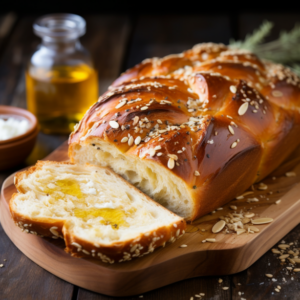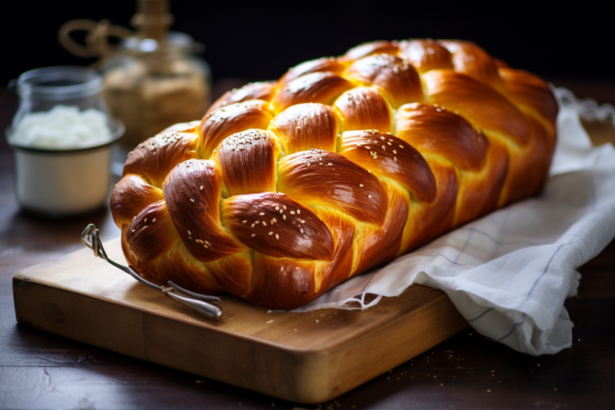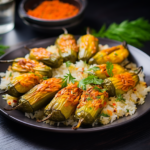Imagine sinking your teeth into a soft, flavorful bread enriched with butter, aromatic spices, and a hint of citrus. This delightful treat, known as Greek Tsoureki, holds a special place in the hearts of Greeks worldwide. From family gatherings to religious celebrations, this sweet bread has been a staple in Greek cuisine for centuries, bringing people together through its irresistible taste and warmth to every occasion. Join us on a journey as we explore the rich history and timeless tradition of Greek Tsoureki, the bread that binds. The word itself may be unfamiliar to many. Still, in Greek culture, Tsoureki holds a special place as a traditional sweet bread deeply woven into their culinary heritage.  With its rich history, intricate preparation process, and symbolism in Greek culture, Tsoureki has become an essential element of various celebrations and a symbol of unity. Whether enjoyed during Easter, weddings, or religious offerings, Tsoureki’s distinct taste and texture have captivated taste buds worldwide.
With its rich history, intricate preparation process, and symbolism in Greek culture, Tsoureki has become an essential element of various celebrations and a symbol of unity. Whether enjoyed during Easter, weddings, or religious offerings, Tsoureki’s distinct taste and texture have captivated taste buds worldwide.
Origins of Tsoureki
Dating back centuries, Tsoureki has its origins deeply rooted in Greek tradition. The sweet bread is believed to have been introduced to Greece during the Ottoman Empire. As people started migrating from Central Asia, a similar bread called “kulcha” made its way into Greek households; it gradually became known as Tsoureki. Today, Tsoureki remains a beloved treat, connecting Greeks to their cultural heritage and reminding them of their resilient history.
Traditional Ingredients
The allure of Tsoureki lies not only in its delightful taste but also in the careful selection and combination of its ingredients. The traditional recipe for Tsoureki typically includes flour, sugar, milk, butter, eggs, yeast, vanilla, and a touch of aromatic spices such as mahlepi and mastiha. These fragrant spices lend the bread its distinctive aroma, making every bite a delightful experience. The ingredients are carefully measured, mixed, and kneaded to create a dough that is elastic and soft, an essential characteristic of a perfect Tsoureki loaf.
Symbolism in Greek Culture
In Greek culture, Tsoureki holds a significant symbolic meaning. The braided shape of the bread is often associated with the Holy Trinity, representing the Father, the Son, and the Holy Spirit. The red-dyed Easter egg placed in the center of the Tsoureki symbolizes the resurrection of Jesus Christ. Sharing Tsoureki during Easter is believed to bring good luck and blessings to those who partake. Beyond religious symbolism, Tsoureki is also seen as a symbol of unity, bringing loved ones together during joyous occasions and fostering a sense of togetherness within the community.
Preparation Process
Every step in the preparation process of Tsoureki is crucial in creating the perfect loaf of sweet bread. Each stage requires precision and care, from mixing the dough to adding aromatic flavors, braiding and shaping, and finally, applying the finishing touches with an egg wash and toppings.
Mixing the Dough
To achieve the desired texture of Tsoureki, the ingredients are mixed thoroughly. Flour, sugar, yeast, and warm milk are mixed until a soft, elastic dough is formed. The addition of butter and eggs adds richness and enhances the flavor. Kneading the dough for an extended period is key to developing the gluten, resulting in a light and airy final product.
Adding Aromatic Flavors
What sets Tsoureki apart from other breads is the enchanting aroma infused with the addition of spices. Mahlepi, a spice made from the ground seeds of the Mediterranean wild cherry tree, adds a subtle nutty and floral note. Mastiha, a resin derived from the bark of the mastic tree, brings a unique and refreshing pine-like flavor. These aromatic spices encapsulate the essence of Tsoureki and create a sensory experience like no other.
Braiding and Shaping
 After the dough has risen, it is time to transform it into the signature braided shape that Tsoureki is known for. Traditionally, three strands of dough are delicately braided together, symbolizing unity and togetherness. The braided loaf is then shaped into a circle or twisted into a wreath, depending on the occasion. This intricate process requires patience and a gentle touch to ensure the final presentation is beautiful and delicious.
After the dough has risen, it is time to transform it into the signature braided shape that Tsoureki is known for. Traditionally, three strands of dough are delicately braided together, symbolizing unity and togetherness. The braided loaf is then shaped into a circle or twisted into a wreath, depending on the occasion. This intricate process requires patience and a gentle touch to ensure the final presentation is beautiful and delicious.
Egg Wash and Topping
Before baking, Tsoureki receives a final touch of visual appeal with an egg wash. A mixture of beaten eggs and milk is brushed onto the dough, giving it a golden, shiny finish. Additional toppings, such as sesame seeds or slivered almonds, can be added for a delightful crunch and added flavor. These finishing touches enhance the aesthetic appeal of Tsoureki, making it even more enticing to the eyes.
Tsoureki Variations
While the traditional Tsoureki recipe is a beloved classic, various delightful variations cater to different tastes and preferences. These variations showcase the creativity and adaptability of Tsoureki while keeping the essence of its flavor and texture intact.
Chocolate Tsoureki
For those with a sweet tooth, Chocolate Tsoureki is an indulgent twist on the classic recipe. The addition of melted chocolate to the dough creates a rich, chocolaty flavor that complements the sweet bread perfectly. Chunks of chocolate or chocolate chips can also be added for an extra burst of chocolatey goodness.
Orange Tsoureki
Adding a citrusy twist to Tsoureki, Orange Tsoureki incorporates orange zest and juice into the dough, infusing it with a refreshing and tangy flavor. The bright and vibrant aroma of oranges combined with the sweet bread makes for a delightful combination that will surely please the palate.
Almond Tsoureki
If you enjoy the nutty flavor and crunchy texture of almonds, Almond Tsoureki is the perfect choice for you. Finely ground almonds or almond extract can be added to the dough to infuse it with that distinct almond essence. Topped with slivered almonds, this variation offers a delightful crunch in every bite.
Saffron Tsoureki
Saffron, one of the most expensive and luxurious spices in the world, adds a touch of elegance to Tsoureki. Saffron threads, steeped in warm milk, impart a rich golden hue and a subtle, earthy flavor. Saffron Tsoureki stands out not only for its unique color but also for the delightful depth of flavor it brings to the table.
Tsoureki Traditions
In Greek culture, Tsoureki plays a significant role in various traditions and celebrations, adding a touch of sweetness and symbolism to these joyous occasions.
Easter Celebration
As one of the most important holidays in Greece, Easter holds a special place in Greek culture. Tsoureki is an integral part of Easter celebrations, symbolizing the resurrection of Jesus Christ. The red-dyed Easter egg placed in the center of the Tsoureki signifies new life and is often cracked against other eggs in friendly competitions. Breaking Tsoureki with loved ones during Easter will bring good luck and prosperity.
Wedding Symbolism
Tsoureki is not only reserved for religious celebrations but also plays a role in traditional Greek weddings. A large round Tsoureki, symbolizing unity and eternal love, is often used as a centerpiece during the wedding ceremony and is shared by the bride and groom. It represents the union of two families and the beginning of a new chapter in their lives.
Religious Offerings
Throughout the year, Tsoureki is also offered as a religious offering in Greek Orthodox churches. A loaf of beautifully braided Tsoureki may be presented during special occasions, such as feast days or during the Divine Liturgy, as a symbolic gesture of gratitude and devotion.
Tsoureki in Greek Cuisine
While Tsoureki is undoubtedly a delightful treat, it can also be incorporated into various mouthwatering dishes that highlight its unique flavor and texture.
Tsoureki French Toast
Transforming Tsoureki into a delectable breakfast or brunch dish, Tsoureki French Toast is a heavenly combination of rich, eggy bread with a hint of sweetness. Slices of Tsoureki are soaked in eggs, milk, and vanilla, then pan-fried until golden brown. Served with dabs of honey or a sprinkle of powdered sugar, Tsoureki French Toast is a decadent treat that will leave you craving more.
Tsoureki Pudding
With its soft, doughy texture, Tsoureki lends itself perfectly to indulgent desserts, one of which is Tsoureki Pudding. To make it, tear the Tsoureki bread into small pieces and soak them in a mixture of milk, eggs, sugar, and warm spices. Then, bake until golden and bubbling. It’s perfect for any occasion and will leave you feeling satisfied and happy.
Tsoureki Ice Cream Sandwich
For a refreshing twist, Tsoureki can be transformed into a delectable ice cream sandwich. Thin slices of Tsoureki are filled with a generous scoop of ice cream, creating the perfect balance between the sweet bread and the cold, creamy delight. This delightful treat is sure to be a hit during the summer months, offering a cool and satisfying dessert option.
Tsoureki in Popular Culture
Beyond its significance within Greek culture, Tsoureki has also made its mark in popular culture, becoming a celebrated aspect of various art forms and festivities.
Greek Festivals
In many Greek festivals, such as the renowned Greek Food Festival, Tsoureki is a star attraction. Visitors flock to these events to experience the cultural celebration and indulge in the rich flavors of Tsoureki. These festivals often showcase the baking process and offer samples of this beloved treat to attendees.
Tsoureki in Greek Mythology
Greek mythology, with its rich narratives and symbolic stories, has also embraced the essence of Tsoureki. In one tale, it is said that the goddess Demeter, known as the goddess of grains and bread, presented Tsoureki to humans as a gift of nourishment and prosperity. This mythological connection further emphasizes the significance of Tsoureki as a symbol of abundance and unity.
Tsoureki in Literature and Art
Tsoureki has also inspired writers and artists to immortalize its beauty and cultural importance. From poems and stories that mention Tsoureki as a symbol of family gatherings and celebration to paintings and sculptures that showcase the exquisite braided loaves, Tsoureki has found its place in the world of literature and art, capturing the imaginations of creatives around the world.
Tsoureki Around the World
While Tsoureki has its deep roots in Greek culture, its influence has spread far and wide, captivating taste buds and bringing joy to people across the globe.
Influence on Mediterranean Cuisine
The enchanting flavors and textures of Tsoureki have influenced various Mediterranean cuisines. Similar sweet breads, such as Pane di Pasqua in Italy and Cozonac in Romania, share many similarities with Tsoureki, reflecting the cultural exchanges and culinary connections within the region.
Global Popularity
With the rise of globalization and the growing popularity of Greek cuisine, Tsoureki has gained recognition and appreciation beyond Greek communities. Bakeries and specialty stores around the world now offer Tsoureki, allowing people from different backgrounds to savor this unique and delicious bread.
Tsoureki in Greek Diaspora
Tsoureki has also found a home within Greek diaspora communities, where it serves as a delicious reminder of their cultural heritage. Greeks living abroad continue to uphold the tradition by baking Tsoureki during important holidays and passing down family recipes from generation to generation.
Health Benefits of Tsoureki
While Tsoureki is undoubtedly a treat for the taste buds, it also offers some health benefits when enjoyed in moderation.
Nutritional Content
Tsoureki is a good source of carbohydrates, providing energy to the body. The bread also contains protein from eggs, essential for muscle growth and repair. Additionally, Tsoureki offers essential vitamins and minerals, including calcium, iron, and phosphorus, supporting overall health and well-being.
Digestive Benefits
The fiber content in Tsoureki, primarily from the flour, contributes to digestive health. Fiber aids in digestion and promotes regular bowel movements, supporting a healthy digestive system.
Tips for Making Perfect Tsoureki
For those who wish to embark on the culinary adventure of making Tsoureki at home, here are some tips.
Yeast Activation
Activating the yeast properly is essential for a well-risen Tsoureki. Ensure the water or milk used to activate the yeast is warm but not too hot, as excessive heat can kill the yeast. A little sugar can be added to the liquid to feed the yeast, helping it to activate and rise.
Proper Kneading Techniques
Kneading the dough allows for the development of gluten, resulting in an elastic texture. Avoid adding excessive flour during kneading, as this can lead to a dense final product. It is advisable to knead the dough until it becomes smooth and slightly sticky.
Rising and Proofing
To ensure a light and airy Tsoureki, it is important to allow the dough to rise properly. Find a warm, draft-free place for the dough to rise, covering it with a clean kitchen towel or plastic wrap. The ideal temperature for rising is around 80°F (27°C). Once the dough has doubled in size, gently punch it down and let it rise again for optimal texture.
Baking Time and Temperature
Every oven is unique, so it is important to monitor the baking process carefully. Preheat the oven to the recommended temperature as per the recipe, and position the rack in the center to ensure even heat distribution. Bake the Tsoureki until it develops a golden brown crust and a hollow sound when tapped on the bottom. The internal temperature should reach around 190°F (88°C) for a fully baked Tsoureki.
Conclusion
As we explore the rich history, symbolism, and traditions surrounding Tsoureki, it becomes evident that this sweet bread holds a special place in Greek culture. From its origins during the Ottoman Empire to its presence in various celebrations and its influence on global cuisine, Tsoureki continues to bring people together and serve as a symbol of unity. Whether enjoyed during Easter, weddings, or religious offerings, Tsoureki transcends boundaries and offers a delightful taste of Greek culinary heritage. So, the next time you savor a slice of Tsoureki, remember the centuries of tradition and celebration baked into every delightful bite.
FAQ 1: What is Greek Tsoureki?
Greek Tsoureki is a traditional brioche-like bread that’s a staple in Greek celebrations, particularly during Easter. Its rich, sweet flavor and soft, fluffy texture make it a favorite. Enriched with eggs and butter, and often flavored with mahlab or mastic, it symbolizes the joyous spirit of Greek festivities. Learn more about Greek culinary traditions and try out the Greek Mezes Recipe to complement your Tsoureki.
FAQ 2: How do you make authentic Greek Tsoureki?
Authentic Greek Tsoureki is made by creating a yeast dough that is enriched with butter, eggs, and milk. The dough is traditionally flavored with the aromatics of orange zest and unique spices like mahlab. For a detailed recipe and culinary guidance, explore Greek cuisine further with Chef on a Bike, your guide to authentic Greek recipes.
FAQ 3: What makes Tsoureki unique compared to other sweet bread?
Tsoureki stands out due to its distinctive ingredients like mahlab, mastic, and cardamom, which impart a uniquely aromatic flavor profile. It’s often braided, which not only makes it visually appealing but also represents the Holy Trinity in Greek Orthodox tradition. Pair it with a Greek Breakfast for a truly Hellenic experience.
FAQ 4: Where can I learn more about baking Greek Tsoureki?
To dive deeper into baking Greek Tsoureki, consider visiting comprehensive culinary platforms sponsored by Digital Heroes Caffe and Financial Navigator 360. These sites offer a wealth of information, from traditional techniques to modern twists on classic recipes, and feature insightful articles and interactive cooking sessions.
These FAQs aim to engage users by answering common questions about Greek Tsoureki while subtly incorporating keywords and relevant hyperlinks to enhance the content’s SEO performance. With a focus on semantic richness, they provide users with a blend of informative content and resources for further exploration.
.
Discover more about the synergy of technology and Greek gastronomy with Bob Stavrou’s insights at Chef on a Bike.


















